Sixers' Daryl Morey Has the Keys to the East

Welcome to the Morning Shootaround, where every weekday you’ll get a fresh, topical column from one of SI.com’s NBA writers: Howard Beck on Mondays, Chris Mannix on Tuesdays, Michael Pina on Wednesdays, Chris Herring on Thursdays and Rohan Nadkarni on Fridays.
Daryl Morey, like any team president with title hopes, has plenty to worry about—injuries, egos, scheming rivals, salary-cap arcana—so his first major decision in Philadelphia needed to be simple and unequivocal, lest it consume too much mental energy. He chose Pat’s over Geno’s, and he hasn’t looked back since.
“I’m going to offend everyone in Philadelphia,” Morey says sheepishly, “because honestly I went to Pat’s just on accident, in the first few days I was here. It just happened to be the one I drove past, and I was, ‘Oh, I’ve heard of that one, I’ll try it.’ And it was very good. And now it’s almost like a duck getting imprinted to its mother.”
Morey, who was hired by the 76ers last November, surely understands the perils of wading into Philly’s cheesesteak wars, but given the wild success of his team so far— a 24-12 record at the All-Star break, tops in the Eastern Conference—one assumes the locals will grant him some leniency.
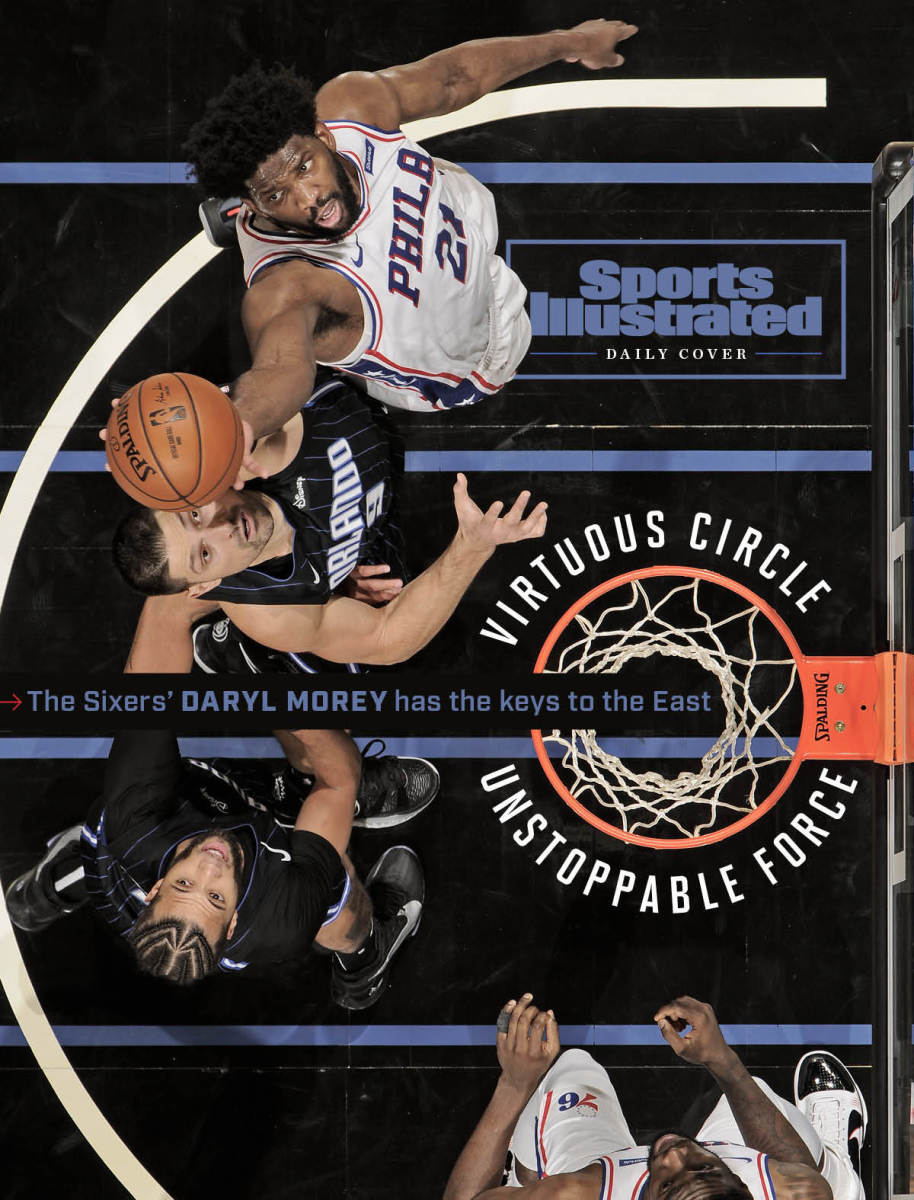
“But you know, everyone here has an opinion,” Morey says. “I’m sure I’ve lost all street cred in Philadelphia right now. I just keep ordering Pat’s, because I'm like, ‘Oh, Pat’s is good,’ so why mess with it?”
(Author’s note: I’m partial to Jim’s on South Street, because the first time I went they used real cheese, instead of the gross canned stuff, and so I declared them the “healthy choice.” I will be taking no questions at this time.)
Really, it’s hard to argue with any choices Morey has made in the last five months. He left the Rockets in October, after 13 years as general manager, avoiding the franchise meltdown that commenced shortly thereafter, with Russell Westbrook and James Harden demanding trades. He joined the Sixers two weeks later, inheriting a talent-rich roster featuring young All-Stars Joel Embiid and Ben Simmons. The roster did need some tweaks, and the ones Morey made—trading starters Al Horford and Josh Richardson for shooters Danny Green and Seth Curry—have worked out brilliantly, giving the Sixers’ stars more room to operate.
It all has Morey, 48, energized and practically giddy, which is saying something for a famously analytics-minded exec who frets over every detail and every percentage point of variability.
“Obviously, the business can be miserable at times,” Morey says, “so it's also important to celebrate when things are going well. That said, I mean, obviously the eye is on the prize—and championship is the goal.”
The Sixers have been in that conversation before, of course, only to be snuffed out in the Eastern Conference semifinals in 2018 and 2019, followed by a first-round exit in the NBA bubble last summer. This season feels different.
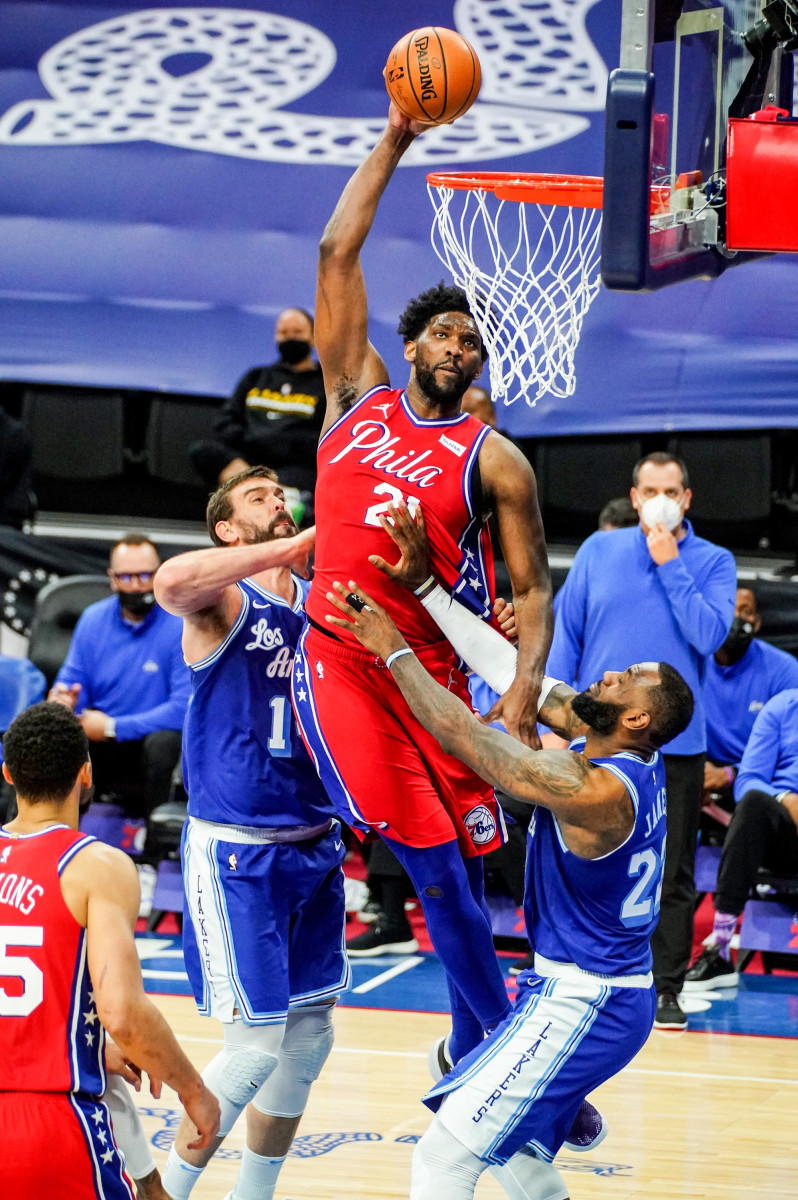
Embiid is now a leading MVP candidate, averaging a career-best 30.2 points, along with 11.6 rebounds, 3.3 assists and 1.4 blocks, while shooting career highs from both two-point range (54%) and the arc (41.6%). The versatile Simmons continues to fill box scores (16.1 points, 7.9 rebounds, 7.6 assists), while suffocating opposing scorers at every position. And Tobias Harris, in the midst of one of his best seasons—20.2 points, 7.6 rebounds, career-high .567 effective field-goal percentage—pushed his way into the All-Star reserves conversation.
Better spacing and a more functional lineup have helped. But Morey mostly credits coach Doc Rivers (whose hiring predated his by a month) and the massive leap taken by Embiid, the 26-year-old center whom Morey calls “an unstoppable force.”
Case in point: Embiid’s destroying Jazz star Rudy Gobert, a two-time Defensive Player of the Year, with a 40-point, 19-rebound performance in a Sixers victory last Wednesday.
“I get in trouble when I say stuff like this,” Morey says, “but he’s the most unstoppable thing I’ve ever seen. And I've seen a lot. You know who I’ve seen,” he says, alluding to Harden. “But I’ve never seen anything like it. Like last night against Rudy Gobert, he faced him up at eight feet, and I mean it ended in a dunk. And (Gobert) is an amazing defender. And he had no answer.”
About that other unstoppable guy, the three-time scoring champion and former MVP who defined a Rockets era and stands as Morey’s signature acquisition: Morey mentions Harden only vaguely, noting, “I can’t say his name anymore, apparently”—a reference to the $50,000 tampering fine the NBA issued for a (seemingly benign) tweet about Harden in December, when Harden was angling for a trade and the Sixers were among the suitors.

The Rockets sent Harden to Brooklyn, his first choice, to join stars Kevin Durant and Kyrie Irving—making the Nets perhaps the greatest threat to the Sixers’ title hopes. It’s a cruel twist for Morey, who acquired Harden in 2012 and championed him for the next eight seasons.
“I mean, it's annoying,” Morey says of the Nets’ superteam. “I would rather have all the good players in the West. So that’s probably annoying. But you know, everything else will get me fined, I think.”
And because he prefers not to be fined again, Morey dares not say what he thinks of Harden’s latest evolution in Brooklyn, where he is shooting less and playmaking more, and selflessly doing all the things critics once doubted he could do. But if Morey could comment, he would surely say something like: Harden is a great player who will always do what his team needs. The Rockets needed him to score a lot, so he did. The Nets need Harden to feed their other stars, so he does. Harden is about winning, so nothing he’s doing now is really new.
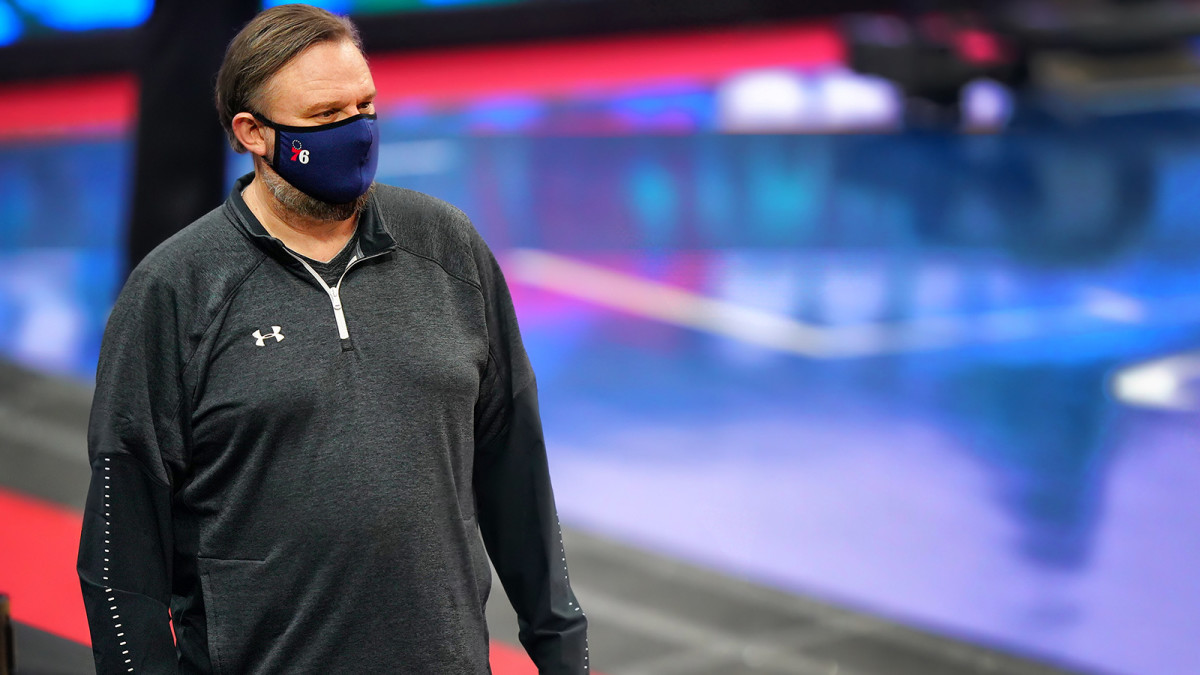
Morey is much chattier when it comes to the Sixers’ own Big 3, rarely mentioning one star without the other two (“Joel, Ben and Tobias,” he says repeatedly). And for a guy who’s often caricatured as an emotionless stats nerd, he describes the Sixers’ success in surprisingly flowery terms. He praises the stars for their “great camaraderie” and “collective will and want-to,” credits Rivers for creating the environment that “allows that to flourish” and says they are benefiting from a “virtuous cycle effect,” in which belief begets winning, which begets more belief.
“And that belief then reinforces Joel, Ben and Tobias and how they feel about how everything’s going, so they play a little better,” Morey says. “I don’t think it’s an accident that all of Joel, Ben and Tobias are having their best years; I think one of Doc’s many strengths is to get the best out of players.”
More than any roster tweak, the Sixers needed an infusion of belief after their crushing, 4–0 defeat by the Celtics in the first round of the playoffs last August—arguably the low point of the Embiid-Simmons era. Within months, the franchise would replace coach Brett Brown with Rivers and import Morey to work with incumbent general manager Elton Brand.
There’s a vague parallel here to Morey’s arrival in Houston in 2006, when the Rockets featured two towering stars of that era, Yao Ming and Tracy McGrady, each in their primes, and seemingly positioned to contend for titles until injuries derailed them. Morey spent years reshuffling the roster and stockpiling assets until he finally landed Harden, turning the Rockets into one of the best teams of the decade.
If not for the emergence of a Warriors superteam (featuring Durant), some ill-timed cold shooting and some bad luck, perhaps Morey would already have a championship to his credit. This time feels different. Embiid and Simmons are just hitting their strides and seem to be in perfect sync, and Harris lends a necessary third dimension—a scorer-playmaker who can anchor second units and serve as a go-to shooter in the clutch, all of which, Morey says, gives the Sixers “a formula for a team that can win the title. It’s very exciting.”
There’s a superteam in Brooklyn to deal with, eventually, but Morey seems relieved to have escaped the murderer’s row of the Western Conference, where LeBron James and Anthony Davis now reign, where multiple MVP candidates lead potential title contenders and where the Warriors still lurk.
“Please, please let me be in the East forever,” Morey says, chuckling. “I mean, the West is just brutal.”
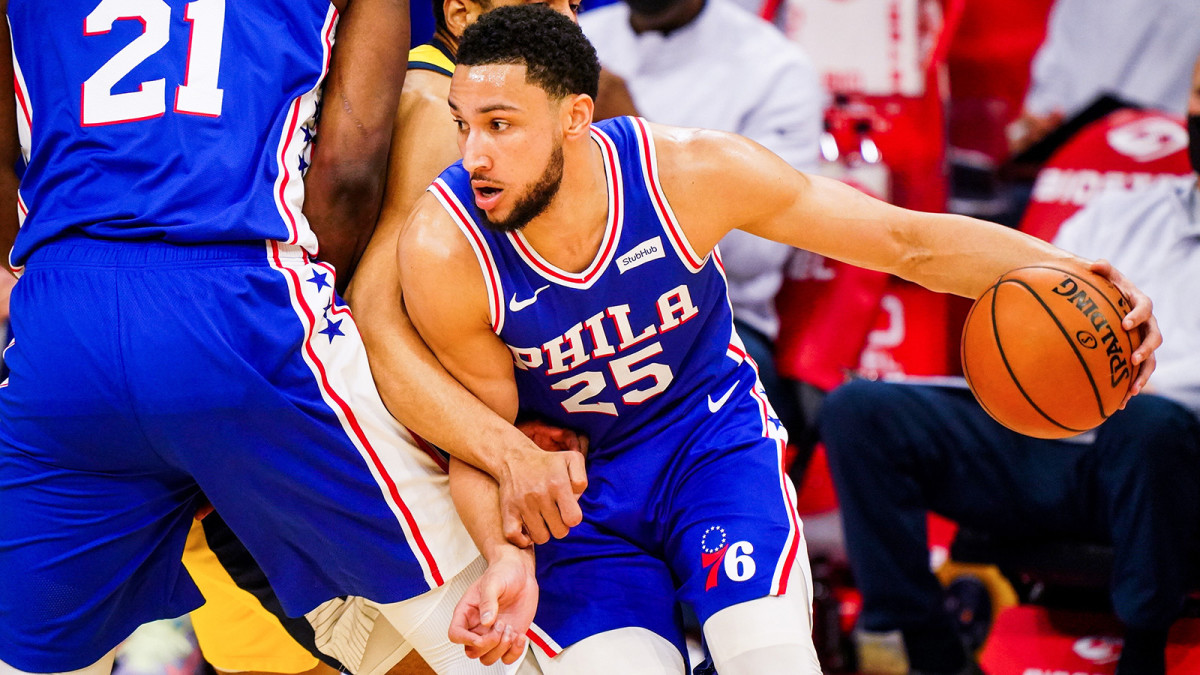
Besides, he says, the gritty vibe of Philadelphia reminds him (favorably) of Cleveland, where he grew up, as well as Chicago and Boston, where he spent formative years as an adult.
“It just feels like I'm back home a little bit,” he says. “The passion of those Browns fans is the passion I feel (from fans) for the Sixers. Obviously, they have a passion for the Eagles, as well, in a frightening way. Like, they're ready to blow up the Eagles’ stadium—and they won the Super Bowl recently! Like, even if we win the title, they’re going to be tarring and feathering us the next year.”
Morey laughs. He understands where he is, the opportunity before him and the consequences for disappointing his adopted new city. And so he’ll stick with Pat’s, too, even if he risks a backlash from the Geno’s loyalists.
“I feel sort of one with the fans here,” Morey says. “I love it, actually.”
Lukewarm take of the week: All-Star rosters don’t need expanding
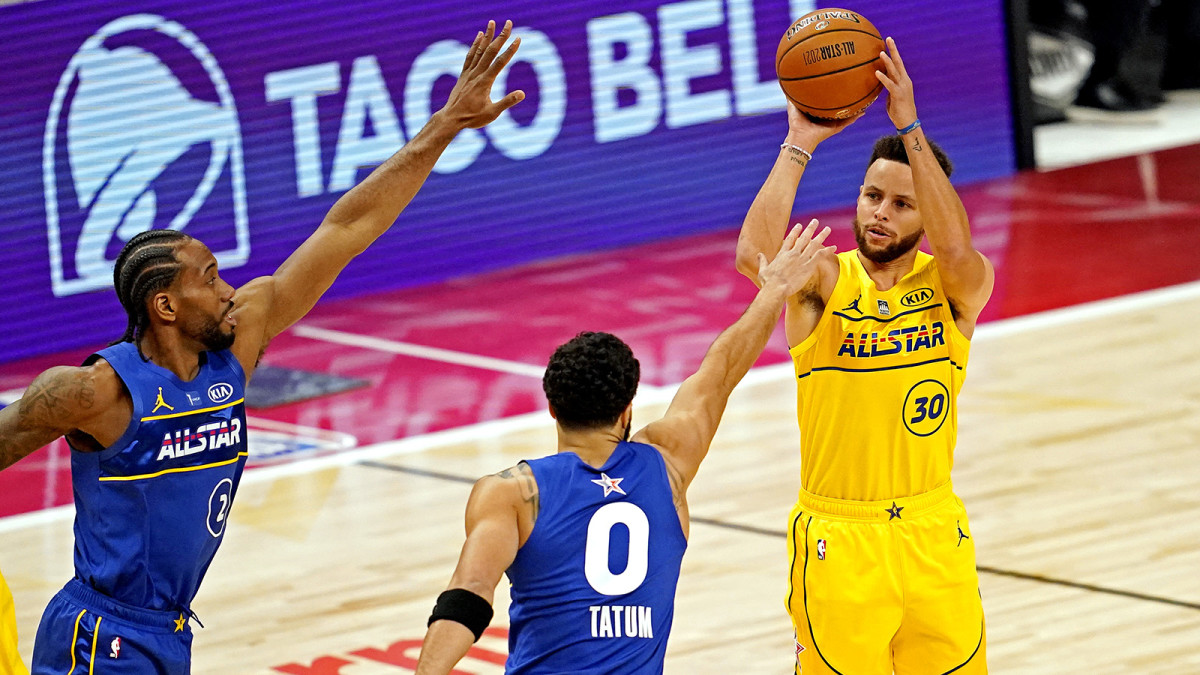
The always-frothy debate over All-Star “snubs” was even frothier this year, because of a remarkably deep pool of talent. It’s still stunning that Heat stars Jimmy Butler and Bam Adebayo were both left out (along with Trae Young, Tobias Harris, Fred VanVleet, Gordon Hayward, Brandon Ingram and others). But expanding All-Star rosters would be a mistake.
There will always be snubs, whether rosters remain at 12 per conference, or go to 13, 14 or 15. Arguing over snubs is part of the fun. It’s also how we know this honor is meaningful. Painful omissions remind us the bar for entry is high, as it should be.
Case in point: Hardcore fans know that Mike Conley was worthy of All-Star honors many times before this year. He just had the misfortune of playing in an era (and a conference) with Kobe Bryant, Stephen Curry, Klay Thompson, Chris Paul, James Harden, Damian Lillard and Russell Westbrook. For all his considerable skills and leadership, Conley wasn’t better than those guys. That contrast helps us see where the line is between “franchise star” and All-Star.
Besides, expanding rosters wouldn’t end the debate, just shift it from one set of worthy players to another. If rosters had gone 14 deep this year (allowing, say, Butler and Adebayo to make it), we’d still be fretting about Harris and Van Vleet. If we went 15 deep, we’d still be wondering about Hayward and Malcolm Brogdon. Eventually, the debate slides into absurdity (and a less-stellar pool of snubs).
All-Star voting has always been a gloriously flawed exercise—part popularity contest (fan voting), part politics (coaches picking reserves), part analytics debate. It’s an honor based on a half-season of stats, which is absurd on its face. If you’re worried about posterity (or your favorite player’s Hall of Fame chances), the All-NBA team is a much more accurate and weightier designation.
Anyway, without All-Star snubs, what would we argue about on Twitter? (O.K., never mind.)
